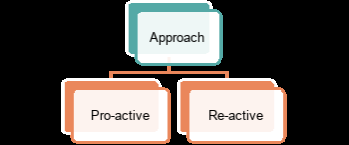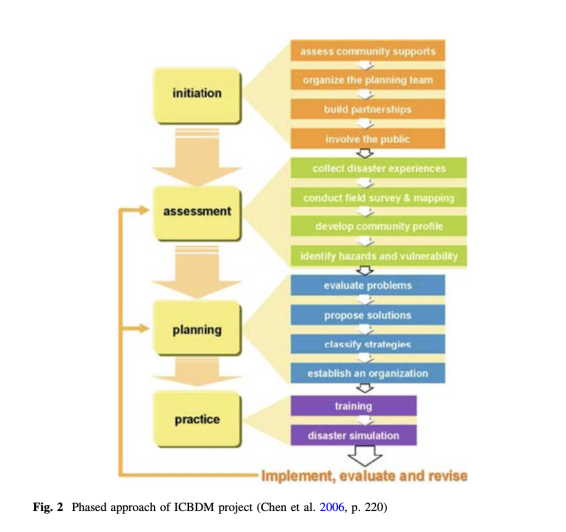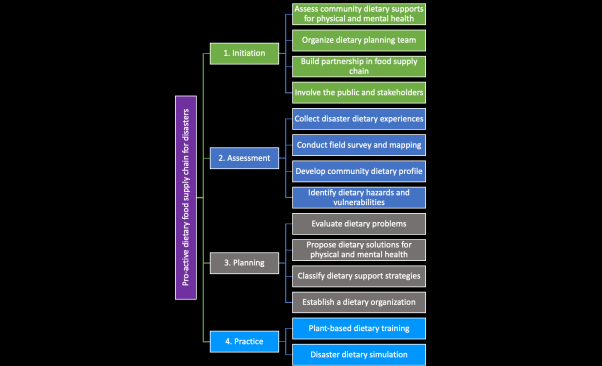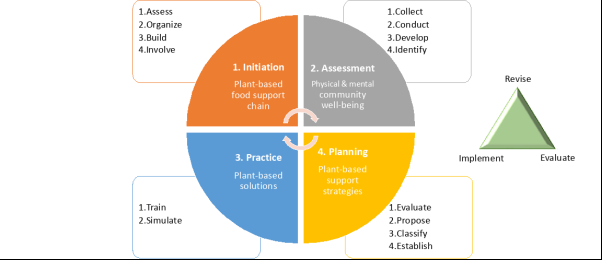Researcher Network member, Jana Krizanova, explores the role of plant-based nutrition in disaster management.
Plant-based provisions during natural disasters
Disasters constitute a complex problem at a global level. Every year individuals and communities are being affected by disasters, which deteriorate their mental health and well-being. Economic and social development throughout the world is frequently interrupted by natural disasters (Makwana, 2019).
Disasters and its management
The United Nation International Strategy for Disaster Reduction (UN-IDSR) defines disaster as a serious disruption of the functioning of a community or a society causing widespread human, material, economic or environmental losses which exceed the ability of the affected community or society to cope using its own resources. World Health Organization (WHO) defines disaster as a sudden ecologic phenomenon of sufficient magnitude to require external assistance (Makwana, 2019).
There are two main origins of hazards, namely natural and technological/man-made disasters. Natural disasters include three specific groups (Moe & Pathranarakul, 2006):
- Hydro-meteorological disasters. Including floods and wave surges, storms, droughts and related disasters (extreme temperatures and forest fires), and landslides and avalanches.
- Geophysical disasters. Divided into earthquakes and tsunamis and volcanic eruptions.
- Biological disasters. Covering epidemics and insect infestations.

In disaster management, we appreciate two types of approaches, pro-active and reactive (Moe & Pathranarakul, 2006). The present conceptual work focuses on the pro-active perspective.

Vegetarianism and the Covid 19 pandemic
With regards biological disasters, here we can include the recent COVID-19 pandemic. Prior evidence proves a link between biological disasters such as COVID-19 and dietary habits (Kim et al., 2021). Kim and colleagues found in a population-based case-control study in six countries that following a plant-based dietary pattern was associated with 73% lower odds of moderate-to-severe COVID-19-like symptoms.
In addition, once individuals have already been infected with COVID-19 they may continue to experience symptoms after the acute phase of infection and report fatigue, sleep difficulties, anxiety and depression. These symptoms are called “long-COVID” symptoms and may last weeks to months and impose a substantial burden on affected individuals (Storz, 2021) as well as on public health-related costs. In this vein, plant-based diets could perhaps reduce the severity of “long-COVID” symptoms and increase community well-being, although further research is needed (Physicians Committee for Responsible Medicine, 2022; Storz, 2021). Furthermore, important savings and increased optimization of public resources may be attained if plant-based options are promoted.
Natural disasters’ effect on mental health
Along with social and economic losses, affected individuals and communities experience mental instability likely leading to Post Traumatic Stress Disorder (PTSD), anxiety and depression. Although disasters are commonly measured by the cost of social and economic damage, there is insufficient attention to the emotional suffering a person undergoes during and post-disaster. When considering community resilience, we should pay greater attention to psychological and socio-economic distress. The most common mental disorders such as depression and anxiety are expected to increase as a result of these pressures on communities (Makwana, 2019).
Vegetarianism and mental health
Weinstein and de Man (1982) conducted a breakfast experiment on a non-vegetarian sample of male undergraduates from Canada, and concluded that meat eaters experience more negative emotions than vegetable eaters and that high-protein animal-based diets lead to experiencing more aggressive emotions. This finding could be particularly useful for building more peaceful community resilience during the peaks of natural disaster management.
As for depression and anxiety issues, prior research undertaken in a large insurance corporation in the USA reports that a low-fat vegan diet among non-vegetarian insurance employees improved emotional well-being, and reduced levels of anxiety and depression and reported that plant-based diets can improve mood (Agarwal et al., 2015). In China, Weng and colleagues (2012) conducted another experiment among non-vegetarian urban adolescents comparing the effect of Western pattern diet (snacks) with a traditional Chinese diet (food rich in grains, legumes, fruit, vegetables and occasional fish intake) and suggest that animal food and Western style snacks are associated with a greater risk of depression and anxiety.
Plant-based diets for food supply chain in disaster management
Despite the existing linkages between plant-based diets and emotional well-being, more research needs to be undertaken in order to test if meatless options might be helpful for a community during a natural disaster. Furthermore, empirical research should take dietary options into consideration when designing food supply support chains for natural disaster management. Accordingly, prior evidence suggests that plant-based dietary options during natural disaster management are more suitable due to sanitation conditions and perishability (Wien & Sabaté, 2015). For instance, plant-based food groups (dry cereals, nuts, dried fruits, grains and legumes) were considered more suitable, whereas the fresh food groups were deemed ineligible due to sanitation and perishability concerns (Wien & Sabaté, 2015). Furthermore, plant-based diets are acceptable and tolerated across many cultures and religions and therefore this option could constitute an appealing solution for nutrition professionals when creating dietary guidelines for public health institutions and organizations (Wien & Sabaté, 2015).
Another natural disaster example, geophysical in its condition, is a tsunami, such as that which occurred in Yamada (Japan) (Yanagihara, Hatakeyama, & Iwasaki, 2012). During this natural disaster, the evacuees depended greatly on the government to prepare or provide them with food and cooking equipment. However, this became a challenge since the food aid services were unavoidably drawn out for several months. Due to excess of burden on local municipalities, responsible for procuring and supplying food and dietary support for evacuees, the food supply was erratic and lacked effective dietary support. Learning from this experience, it is important to involve registered dieticians during dietary planning, coordination and support in disasters.
Community-based disaster management model (generic perspective)
In Chen’s ICBDM model (Chen & Chan 2006) (see Figure1), we see a community-based perspective on disaster management. The model proposes a four-phased approach to deal with a disaster from a community role standpoint. Specifically, it includes the following stages: 1) initiation, 2) assessment, 3) planning and 4) practice. The stages of assessment, planning and practice are designed to implement, evaluate and revise actions. Each phase entails a detailed endeavour to be performed in order to prepare a community for a disaster management.

Figure 1: The four-phased approach of ICBDM project (Chen et al. 2006, p. 220).
Community-based disaster management model from a plant-based dietary perspective
The aforementioned model (Chen et al., 2006), integrating community’s perspective within the context of disaster management, may serve us as a role model for building a more specific approach focusing on the dietary support chain during a disaster. Based on its previous stages, we may harness its structural framework to create an adapted version with dietary improvements purposes. As a result, we may build a parallel model with a pro-active approach for community-based disaster management focusing on the dietary food supply chain. By these means, we will attempt to design a comprehensive tool to promote community well-being by introducing support programmes that would cover the physical and mental vulnerabilities and hazards of the population and increase social resilience. This may be achieved by inserting plant-based options into food dietary support supply chain in pre, during and post-disaster management occurrences with the main goal to support the physical and mental well-being of the affected population.
Figures 2 and 3: Pro-active model integrating community role in disaster management from the perspective of plant-based dietary food supply chain.

Figure 2: Adapted from the model by Chen et al. 2006

Figure 3 Adapted from the model by Chen et al. 2006
Community pro-environmental and pro-active approach to prevent causes triggering natural disasters
Prior work suggests that both natural and social factors cause disasters, e.g., flooding might be the result of the combination of deforestation and climate change (Makwana, 2019). One possible solution to counteract deforestation, biodiversity loss, and climate change is the shift towards plant-based diets, since animal husbandry has become one of the main contributors to the climate crisis (Pimentel & Pimentel 2003; Tukker et al., 2008; Schösler, De Boer & Boersema, 2012). In addition, the Food and Agricultural Organization (FAO) estimates that food production needs to be increased by 70% in 2050 in order to be able to feed the global population that is in constant growth (FAO, 2009).
Consequently, if we want to bring a more holistic and pro-active perspective on natural disasters management, we also need to consider causes that trigger these events. Having learnt lessons from previous disasters, we may need to explore alternatives to help guarantee higher well-being and resilience. One possible solution to achieve this goal is to provide plant-based options. This could provide benefits at individual and collective levels increasing physical and mental health along with environmental preservation.
In accordance with this, public agents such as committees on disasters management could create a responsible organization that would design a platform or mobile app with dietary instructions accessible from remote. With this in mind, the government could increase community preparedness and resilience by having built the necessary infrastructure to guide the population in their dietary practice pre, during and post-disaster in order to better cope with their hazards and vulnerabilities. This platform or mobile app should provide supporting information and reminders to guarantee adequate nutrition and reduce stress and anxiety.
In conclusion, it is important to bring higher awareness to the public and different stakeholders about the relevance of not only reactive but also pro-active perspective when dealing with the personal, economic and environmental impacts of natural disasters on community well-being and its resilience. An effective proactive management of natural disasters should consider these points when designing an alternative approach to counteract the negative impacts of disasters on population’s well-being. A possible solution has been proposed with likely advantages at individual, environmental and economic levels aiming to empower the community in a more holistic way. Nevertheless, further research needs to be conducted in order to support this.
The views expressed by our Research News contributors are not necessarily the views of The Vegan Society.
References
- Agarwal, U., Mishra, S., Xu, J., Levin, S., Gonzales, J., & Barnard, N. D. (2015). A multicenter randomized controlled trial of a nutrition intervention program in a multiethnic adult population in the corporate setting reduces depression and anxiety and improves quality of life: the GEICO study. American Journal of Health Promotion, 29(4), 245-254.
- Chen, L. C., Liu, Y. C., & Chan, K. C. (2006). Integrated community-based disaster management program in Taiwan: a case study of Shang-An village. Natural hazards, 37, 209-223.
- FAO, 2009. The State of Food and Agriculture. Available at https://www.fao.org/3/i0680e/i0680e.pdf (Last accessed 22 March 2023)
- Kim, H., Rebholz, C. M., Hegde, S., LaFiura, C., Raghavan, M., Lloyd, J. F., ... & Seidelmann, S. B. (2021). Plant-based diets, pescatarian diets and COVID-19 severity: a population-based case–control study in six countries. BMJ Nutrition, Prevention & Health, 4(1), 257.
- Križanová, J. (2020). The relationship of vegetarianism with individual and collective well-being.
- Makwana, Makwana, N. (2019). Disaster and its impact on mental health: A narrative review. Journal of family medicine and primary care, 8(10), 3090.
- Moe, T. L., & Pathranarakul, P. (2006). An integrated approach to natural disaster management: public project management and its critical success factors. Disaster Prevention and Management: An International Journal, 15(3), 396-413.
- Pimentel, D., & Pimentel, M. (2003). Sustainability of meat-based and plant-based diets and the environment. The American journal of clinical nutrition, 78(3), 660S-663S.
- Physicians Committee for Responsible Medicine, Last accessed 13th July 2022 https://www.pcrm.org/
- Schösler, H., De Boer, J., & Boersema, J. J. (2012). Can we cut out the meat of the dish? Constructing consumer-oriented pathways towards meat substitution. Appetite, 58(1), 39-47.
- Storz, M. A. (2021). Lifestyle adjustments in long-COVID management: Potential benefits of plant-based diets. Current Nutrition Reports, 1-12.
- Tukker, A., Emmert, S., Charter, M., Vezzoli, C., Sto, E., Andersen, M. M., ... & Lahlou, S. (2008). Fostering change to sustainable consumption and production: an evidence-based view. Journal of cleaner production, 16(11), 1218-1225.
- UNISDR (2009) Terminology and Disaster Risk Reduction available here: https://www.undrr.org/publication/2009-unisdr-terminology-disaster-risk-reduction
- Weinstein, L., & de Man, A. F. (1982). Vegetarianism vs. meatarianism and emotional upset. Bulletin of the Psychonomic Society, 19(2), 99-100.
- Weng, T. T., Hao, J. H., Qian, Q. W., Cao, H., Fu, J. L., Sun, Y., ... & Tao, F. B. (2012). Is there any relationship between dietary patterns and depression and anxiety in Chinese adolescents? Public health nutrition, 15(4), 673-682.
- Wien, M., & Sabaté, J. (2015). Food selection criteria for disaster response planning in urban societies. Nutrition Journal, 14(1), 1-7.
- Yanagihara, H., Hatakeyama, Y., & Iwasaki, T. (2012). Coordination by registered dieticians for nutritional and dietary support in disaster in Japan. Western Pacific Surveillance and Response Journal: WPSAR, 3(2), 46.

